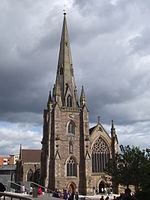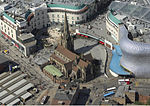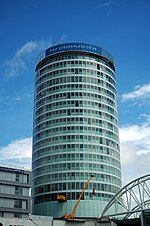Public Office, Birmingham
Buildings and structures demolished in 1911Buildings and structures in Birmingham, West MidlandsCity and town halls in the West Midlands (county)Demolished buildings and structures in the West Midlands (county)Government buildings completed in 1807 ... and 2 more
History of Birmingham, West MidlandsUse British English from April 2022

The Public Office was a municipal building on Moor Street in Birmingham, England, built between 1805 and 1807. It was the first important administrative building in Birmingham, and remained the principal local government centre until the 1880s, when the much larger Council House was constructed. The building was demolished in 1911 to make way for a railway goods station.
Excerpt from the Wikipedia article Public Office, Birmingham (License: CC BY-SA 3.0, Authors, Images).Public Office, Birmingham
Saint Martins Queensway, Birmingham Digbeth
Geographical coordinates (GPS) Address Nearby Places Show on map
Geographical coordinates (GPS)
| Latitude | Longitude |
|---|---|
| N 52.47829 ° | E -1.892981 ° |
Address
Saint Martins Queensway
B5 4BU Birmingham, Digbeth
England, United Kingdom
Open on Google Maps











